The biogas climate change debate spans many considerations. There are undoubtedly many climate change reduction benefits that expanding the production of biogas, and the anaerobic digestion process which makes it, will bring. But, there are also dangers lurking from the production of larger quantities of renewable biogas which can act to accelerate climate change.
Read on to find out our view on the biogas climate change benefits and dangers.
But, to start with here are some basic points to understand:
What is Climate Change?
Climate change is defined as a shift in the statistical distribution of weather patterns. A variety of factors contribute to climate change. These can be naturally occurring factors, such as volcanic eruptions, or they can be linked to human activities, such as the widespread use of fossil fuels.
Where is Biogas Produced?
Biogas is produced when microbial organic matter degrades in anaerobic conditions and can be obtained from:
- covered lagoons,
- landfills, and
- enclosed tanks which are known as “anaerobic digesters.”
Just like fossil fuels, it is flammable and burning it produces carbon dioxide.
What is Biogas?
Biogas is frequently produced from sludge or animal manures high in carbohydrates, proteins, and lipids, and contains a cocktail of methane, carbon monoxide, and trace gases.
How is it that the CO2 from the Combustion of Biogas is Said Not to Warm Our Planet?
Despite the fact that the combustion of biogas produces carbon dioxide, which has been shown to contribute to climate change, all of the carbon present in biogas comes from organic materials.
This carbon occurs naturally in the atmosphere. It is part of the natural cycle and does no harm. It is using mineral carbon deposits which adds to global warming.
Arguably – Biogas Carbon is Quickly Replaced by New Growth
As a result of new growth from the fertilizing effect of the liquid output, biogas is a carbon-neutral fuel source that does not contribute to climate change.
The gas industry has recently made a big push to promote ‘biogas' (also known as ‘biomethane' or ‘green gas') as a climate solution. But, read their publicity carefully because only naturally created methane, and not the result of using fossil-derived natural gas, is climate neutral.
So far in this article, we have listed the points our readers need to know. Now, let's cut through the political rhetoric and get to the facts.
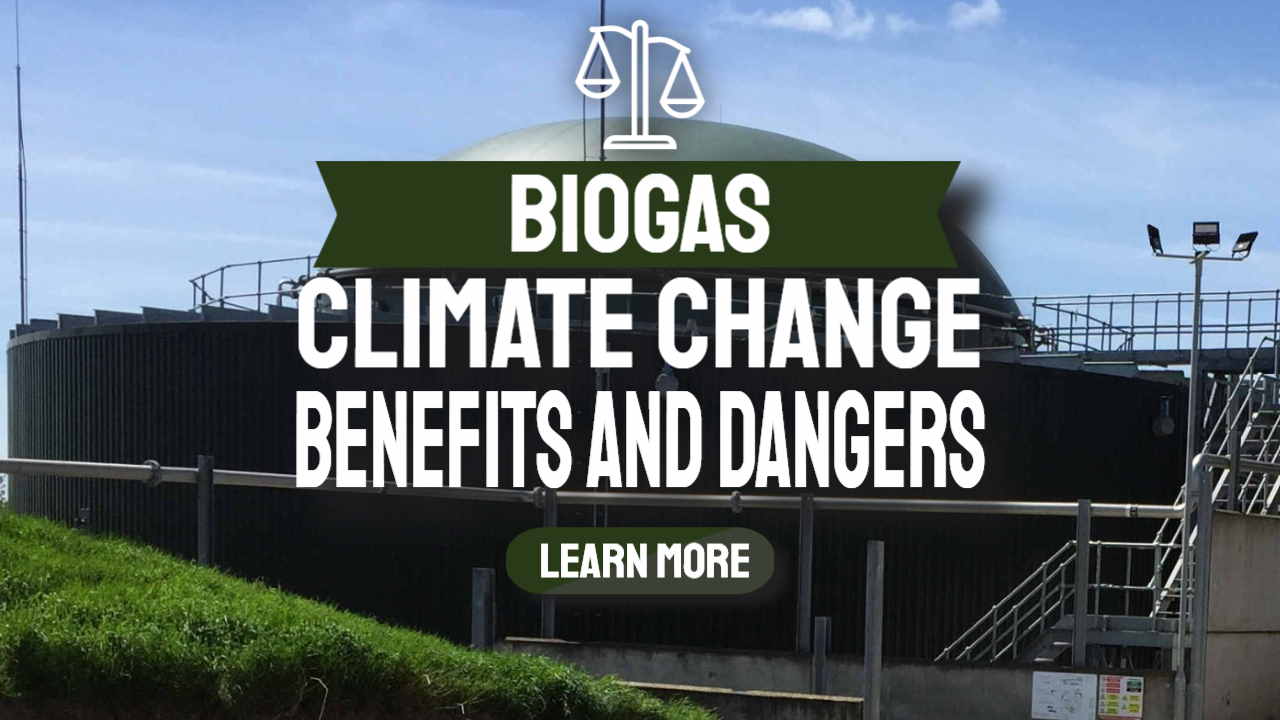
1 – The Biogas Climate Change Benefits
Biogas climate change benefits include its ability to reduce methane emissions, reduce waste, and act as a chemical product in and of itself.
Though biogas (and hydrogen) have many potential benefits as an energy source, the gas industry has until now often used its existence to mislead the public into thinking that natural gas is somehow similar and therefore benign.
Globally natural gas companies have used the existence of biogas to (by association) suggest that natural gas is really clean and wholesome. This has been something of a smoke screen used to extend the life of fossil fuels in our energy system.
Natural gas is a cleaner fossil fuel than coal or oil but don't let anyone tell you that it is in any way a sustainable option to keep using it.
Don't Let Anyone Convince You that Natural Gas is Not a Fossil Fuel!
The gas industry has spent decades attempting to persuade the public that gas is not a fossil fuel that contributes to climate change and harms our health.
Now that it has lost this battle, it has chosen to fight on another front: biogas. Biogas is an important tool in the fight against climate change. But it must be used with caution, especially because the fossil fuel industry may yet use biogas production from chemical fertilisers and using fossil-fuel-powered tractors to make their biogas.
Don't Let Anyone Convince You that we Can All Switch to Biogas Immediately
There is not enough biogas, it is insufficient to reach net zero.
Although biogas plants are multiplying quickly, they cannot be thrown up quickly in Europe or the US to meet 15% say, of the demand for natural gas. Only smaller agriculturally based low-population density nations with very little heavy industry can rapidly raise their biogas production. Denmark for example will raise biogas production in the next 3 years to 47% of their total current natural gas consumption.
Globally the concept of biogas production should not be used to delay other actions on climate change. However, in many nations output of biogas could and many countries will soon produce 10 to 15% of national requirements.
2 – The Biogas Climate Change Dangers
Biogas Contains Methane and Should Not be Allowed to Leak
Any comprehensive plan to combat climate change must address methane emissions in addition to carbon emissions. If not the benefits can easily be lost.
Methane is the second most common greenhouse gas emitted by human activities in the United States (and also in most developed nations). It accounts for approximately 9% of total U.S. greenhouse gas emissions. This percentage must not be allowed to rise and urgently needs to be lowered.
The US EPA has confirmed that the use of biogas reduces methane emissions, which are associated with the combustion of fossil fuels, and supports the Administration's “all-of-the-above” energy strategy.
But, all the good done to limit climate change by using biogas could easily be outdone if the increasing number of businesses and individuals that make it and use it allow it to leak invisibly from their biogas plants.
The Danger from Farm Biogas Plants
Let us be clear. The dangers are not large, but should not be ignored. Farmers are constantly looking for new ways to make a living, but they do this while also being good land stewards.
In fact, an important reason why the emerging biogas industry is becoming important to rural communities everywhere is the dedication of the agricultural community to improving farm sustainability.
Biogas systems that capture methane from farming operations and use it to generate renewable energy currently provided enough renewable energy in 2020 to power nearly 100,000 average American homes across the country. This number will grow fast and this number is already surpassed by many other nations.
Agricultural Biogas Production Must Not Reduce Food Output
Agriculture is being challenged by rising food demand and climate change. Furthermore, most climate change mitigation plans rely on agriculture to increase carbon storage in soils and to produce raw materials for large-scale biofuel and power production.
Anaerobic digestion and biogas production can help solve these by raising food output and using the fertilizer output to improve soils with added carbon.
But, the biogas industry must not be seen to even slightly reduce food production. Therefore, the biogas industry should impose its own good practice rules to avoid all food production losses.
In the EU, the Belgium Government has recently lodged a bill in parliament to legally restrict biogas production to prevent the use of food crops for renewable energy production.
The Danger of Leakage of Methane from Landfills
Keeping organic waste out of landfills is good for the environment.
When these materials decompose in landfills, methane is released into the atmosphere, contributing to climate change. eve the best landfill gas extraction and utilization schemes do no better than capturing about 50% of the methane produced. The extraction systems are run while the waste produces the maximum biogas output rate, and turned off when the gas volume and quality falls. Most extraction systems run for no more than 20 years at most, and yet the waste may easily produce landfill gas for 150 years.
Conclusion and Recommendations
Although it is widely acknowledged that biofuels can contribute to a cleaner global energy mix, the net benefits of bioenergy in terms of mitigating greenhouse gases (GHG) have limits that need to be appreciated.
Improving the efficiency of biogas production, adding new bioenergy sources, and extending others, such as expanding food waste recycling will bring substantial additional increases in biogas output.
However, nations that will ever be able to produce biogas as biomethane equal to 50% of their current natural gas demand, as planned by the Danish Government, will be few.
Some argue that biofuels are not sustainable because converting non-agricultural land to grow energy crops may result in a significant initial decrease in carbon storage, resulting in what is known as a “biofuel carbon debt”.
We do not see that as inevitably a problem as methods such as biochar production can be used to offset all such deficits.
The biogas industry globally needs to develop its ability to operate without using fossil fuels to power farm machinery and its transport needs. It is doing this and will continue to improve.
But, above all:
- Biogas production need not and never should reduce the production of food for human consumption and the industry and governments should legislate to prohibit the use of food crops.
- All biogas producers must take great care not to allow accidental methane leackage from biogas facilities of all kinds. Governments should set stringent targets to minimize all fugitive methane leakage and regular checks to ensure compliance should become routine.
The role of anaerobic digestion and biogas, while essential as part of global decarbonization policy is not the magic solution many people would like it to be.
It is just one important technology that all governments should be developing as rapidly and fully as possible to counter the climate emergency.
Biogas Benefits Essential as Climate Change Carbon Hits Record High and Summer Heat Peaks
The biogas benefits of reducing carbon emissions and the effects of climate change, just became more essential than ever in 2018, as climate change carbon hits a record high and northern hemisphere summer heat has peaked at temperatures never before recorded.
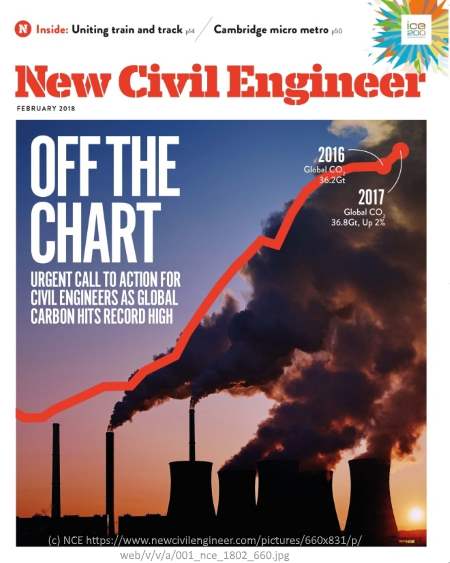
We are now two and a half years on from the historic COP21 deal on climate change, global carbon emissions are higher than ever.
What is going to force society into action?
The deal was described as a “monumental triumph for people and our planet” by then UN secretary general Ban Ki-moon and a wake-up call to our industry by then ICE vice president and long-term climate campaigner Keith Clarke.
“Now we need a revolution in the structure of engineering,” he said.
Because science tells us that it is the level of green-house-gasses in the atmosphere that is unquestionably the cause of climate change, and that is driven by our carbon-dependent society.
And decarbonisation is fundamentally an engineering problem – a civil engineering problem at that. via NCE
False Hope
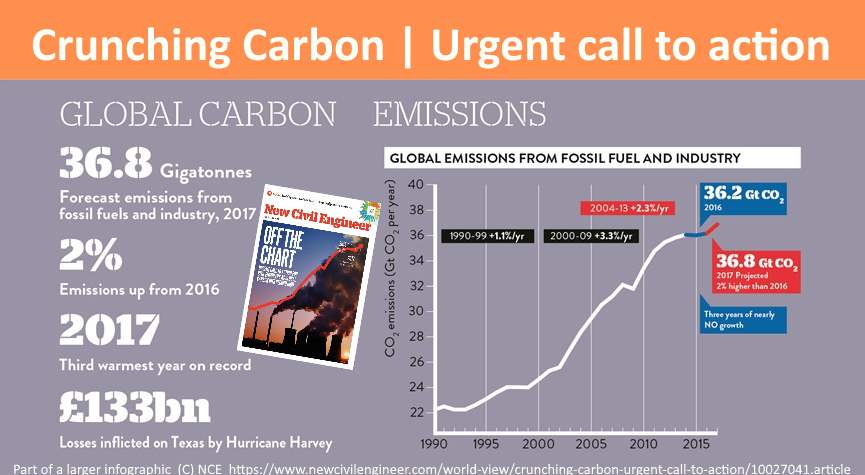
The three stable years, 2014-16, had raised hopes that emissions had peaked.
“Lead researcher Corinne Le Quéré, director of the Tyndall Centre for Climate Change Research at the University of East Anglia, describes the rise as “very disappointing.”
“Time is running out to keep warming well below 2°C let alone 1.5°C”,
she warns.
“Last year we saw more evidence of the likely consequences of climate change, with more intense rainfall, higher sea levels and warmer ocean conditions favouring more powerful storms, amplifying the impacts of hurricanes and cyclones.”
“We need to reach a peak in global emissions in the next few years and drive emissions down rapidly afterwards to address climate change and limit its impacts.” …
Latest figures put the annual bill for repairs and recovery following climate-related events at US$300bn in the United States alone. via NCE
That this bill is set to rise rapidly has only been reinforced, since it was written at the start of 2018, in the light of recent extreme weather conditions. This assertion now appears to be uncontested.
So What is Being Done to Accelerate Climate Change Action?
It could be argued that professional planners, designers, consultants, engineers, and architects, should be joining together across the globe to ensure that they only offer the most sustainable least climate-changing solutions to their clients.
Unfortunately, that will never happen. Throughout all capitalist economies, professionals work for their clients to “briefs” supplied by their clients. They can make suggestions regarding design to reduce climate change, but it is the clients which hold the power to make decisions to increase short-term project costs/ reduce carbon emissions, for long-term gain to society in general.
In reality, professionals can do only so much, and the change is not going to be fast enough.
But, all hope of containing climate change to tolerable levels may not yet be lost.
Most governments are tending to become more right-wing and are increasingly averse to subsidizing industries that can ameliorate climate change through renewable energy (e. g. biogas) and using waste as a lower carbon-emission source of raw materials.
A Lead on Reducing Climate Change Carbon Looks to be Coming from Outside the Civil Engineering Industry/ Professional Advisor Realm
Institutional investors are acting to understand and address the risks to their investments posed by the impacts of climate change.
Companies that fail to advise on the risks to clients will be exposed to the risk of litigation.
The scrutiny follows an initial warning delivered by Bank of England governor Mark Carney in his capacity as chair of the Financial Stability Board in 2015.
Mark Carney’s warning, delivered at Lloyds of London, was high profile and spelled out the potential scale and severity of climate-related risks to global financial markets.
Allison explains: It aims to develop voluntary, consistent climate-related financial risk disclosures for use by companies in providing information to investors, lenders, insurers, and other stakeholders. via NCE
This is where professionals have a duty to inform their clients about the anaerobic digestion process and how the use of biogas benefits reducing carbon emissions and therefore also the effects of climate change. some of the main benefits are summarized below:
Benefits of Anaerobic Digestion as an Energy Producer
All businesses whether agricultural or industrial benefit from the ability to diversify their income sources by installing anaerobic digestion facilities for their organic waste, or sending their waste to AD plants. The AD process, by providing an energy source is ideally suited for owners to benefit in this manner from a greater diversity of business income. Our society also benefits from reduced carbon emissions when projects are suitably implemented.
Benefits of Anaerobic Digestion as a Waste Management Technique
This ability to run businesses more holistically, and avoid wastage of a resource, namely their organic waste, is one of the important benefits of anaerobic digestion. It is becoming much more important for businesses that seek shareholder investment. This is due to the fact, we have mentioned already, of the risks to their investments posed by the impacts of climate change.
Why the Biogas Benefits are Becoming More Important with Each Year that Passes
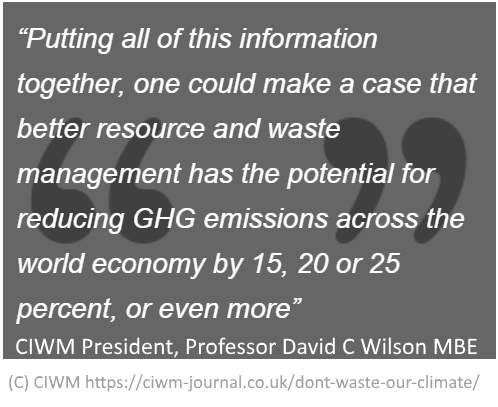 The biogas benefits in the advantageous recycling of waste material have added a new dimension to the waste management domain.
The biogas benefits in the advantageous recycling of waste material have added a new dimension to the waste management domain.
In response, the favourable legal framework which is being set in place in Europe to further harness waste management that would give a suitable boost to the overall Europe biogas industry is a vital factor. Within that framework of a circular economy, the massive development of anaerobic digestion (AD) and of available biogas benefits is an essential component.
AD is not only a renewable energy source. It is also, an environmentally friendly, cost-effective solution to dealing with much of what we think of as waste.
Waste is a massively under-estimated cause of carbon emissions. This has been recently pointed out by the CIWM President, Professor David C Wilson:
“One could make a case that better resource and waste management has the potential for reducing GHG emissions across the world economy by 15, 20 or 25 percent, or even more.
Such numbers by their nature are “guesstimates”, and as such are anathema to climate scientists. However, whatever number we choose to use, the message is still the same. Our sector provides a useful entry point to make very significant contributions to climate mitigation targets. And some of those reductions could be seen as “low hanging fruits”, and/or to offer significant reductions over a short timeframe.” via Don’t Waste Our Climate
If waste materials are not recycled, and are allowed to decay in landfills, methane and carbon dioxide cannot all be collected and will be released into the air and contribute to climate change. But, worse occurs due to the burning of waste in backyards where no proper waste collection is provided in developing nations.
Again quoting the CIWM President, on his own work to assess actual emissions from waste:
“…early results suggest that the CO₂ equivalent of black carbon emissions from uncontrolled burning in backyards in Mexico was 15 times larger compared to methane released from the decomposition of equivalent amounts of combustible biodegradable waste disposed at a final disposal site. This suggests that urgent action is needed to reduce domestic open burning of waste and that this would have a significant impact, both on improving local air quality and respiratory health, and on reducing climate change.” via Don’t Waste Our Climate
We would point out that those very same backyards could be very much more efficiently reducing emissions in they had the biogas benefits of biogas plants installed in them.
Biogas production can play an important role in reducing emissions from such as rotting manure, farm wastes, and slurries, and replacing petrochemical-derived artificial fertilisers.
In so doing, this proven technology will abate significant amounts of carbon emission, and by replacing fossil fuel-derived energy sources the amount of climate-damaging greenhouse gas emissions will be greatly reduced.
Help Us to Publicise the Biogas Benefits: Benefits of Anaerobic Digestion and Biogas Production
Professionals need to inform their clients about anaerobic digestion. But, the benefits of anaerobic digestion and biogas are still not appreciated by all professional opinion-formers as they need to be, before biogas technology can hope to achieve its potential.
We hope that in a small way, reading this article has resulted in your better understanding of the biogas benefits in reducing carbon emissions. And, therefore also the effects of climate change which AD technology can help reduce.
If so, please join us in helping to publicise the potential biogas benefits, from anaerobic digestion and biogas plant development globally for its many climate change and societal benefits.
[Archived article originally published on 15 August 2018. Updated content added July 2022.]

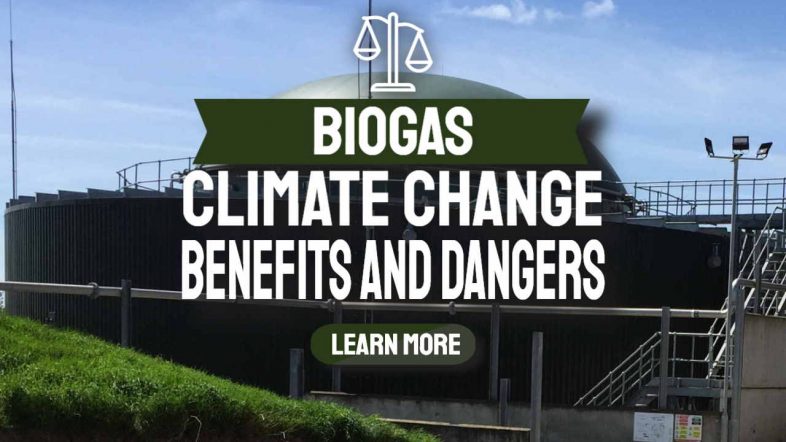



Heya i’m for the primary time here. I came across this and I find the usual scare tactics from vested interests. It really unhelpful in my view to keep pedalling doom.
This is very interesting, You are skilled writer.
I look forward to seeking more of your wonderful post.
Also, I have shared your web site.
Appreciating all work effort you obviously put into your website and in depth information you provide. All ell meaning people must act now on this. Excellent read!
What’s up friends. What you boys worried about! StormChaser having a wild time, and its getting wilder. Join in. http://www.stormchase.us/Organizations.html
I agree. It has been so hot. This needs telling.